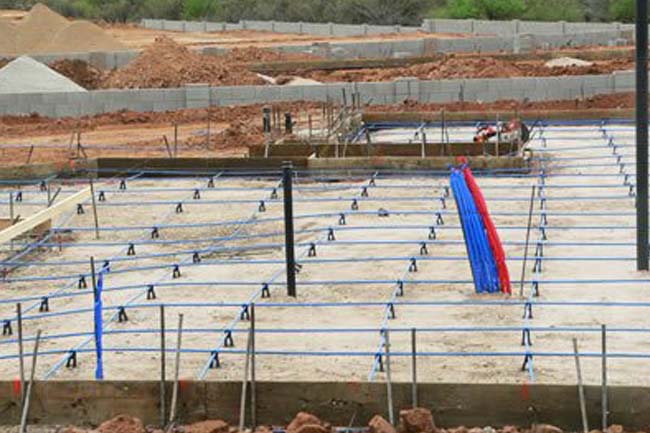Rely on PRIMA PAVIMENTI, the sector professionals
to satisfy every customer need.
POST-TENSIONED METHOD
Post-tensioned joint-less flooring
Technology and Quality
They solve problems of traditional industrial concrete floors, of old conception and specifically the curling phenomena, between main causes of deterioration as that of construction and contraction joints.
The post-tensioned industrial floors are made without joints, have no cracks, no curling occurs. Usually, traditional concrete floors made of slabs have construction and contraction joints that operations of normal working activity, and above all transit of goods handling vehicles, cause to deteriorate rapidly, forming cracks, even deep ones.
Industrial floors made with traditional methods need constant maintenance and restoring of joints: sometimes it is a temporary restoration with resins or with more performing and definitive solutions, such as our Smart Joint®.
The maintenance costs associated with the restoration of cracks, slab subsidence, loss of flatness, of traditional industrial floors increase, as well as the damage suffered by the rigid wheels of the goods handling vehicles. Furthermore, the health of operators, who travel on a not perfectly flat surface, is not protected.
The post-tensioned floor without joints is therefore the highest quality solution to be taken to overcome all limitations we find in the traditional concrete floors, resolving positively constructive problems present especially in dated industrial buildings, without slab cracking risk, or curling, despite the building size and planimetry. Vertical structures, such as pillars, do not constitute any problem for the laying of cables.
Ad hoc design and Realization
In the realization according to the project, attention is paid to the qualitative preparation of the ballast and the substrate, with high planarity and according to the project specifications. There aren’t used metal nets (traditional armor) replaced with a series of steel cables (harmonic steel strands, designed type and number), trimmed, fixed, thesis and embedded in the concrete during casting. During the drying of the concrete, the post-tensioning technique consists in going to counteract the traction of the concrete during the maturation phase, going to tension the cables.
 The tension of the steel mesh makes the concrete casting very resistant, prevents deformation of the surface or typical problems deriving from use during normal working activities. The laying of the concrete is carried out with Laser-Screed which gives it characteristics of high flatness and high resistance. Concrete matures in a “controlled micro-climate”, increasing its technical performance.
The tension of the steel mesh makes the concrete casting very resistant, prevents deformation of the surface or typical problems deriving from use during normal working activities. The laying of the concrete is carried out with Laser-Screed which gives it characteristics of high flatness and high resistance. Concrete matures in a “controlled micro-climate”, increasing its technical performance.
A surface finish is then carried out with chemical and thermo-mechanical hardening treatment, which makes the surface even more resistant to wear, compact and hard. Increases protection and shine, the surface is dustproof.
Why choose post-tensioned joint-less flooring?
- No presence of construction contraction joints
- No curling phenomenon
- No presence of cracks
- Very high flatness
- Optimal for traffic handling vehicles and AGV
- Ideal for logistics, large-scale distribution, and automated warehouses, with shelving at great heights and high static or dynamic loads
- No vertical movement of the concrete slabs when the goods handling equipment passes
- No cost for the maintenance of the floor and especially for the repair of the joints on the flooring, due to the passage of the forklifts
- Dustproof
- Aesthetically more polished
- Increase in the value of the property and investment
 HAI UNA RICHIESTA?
HAI UNA RICHIESTA? 


